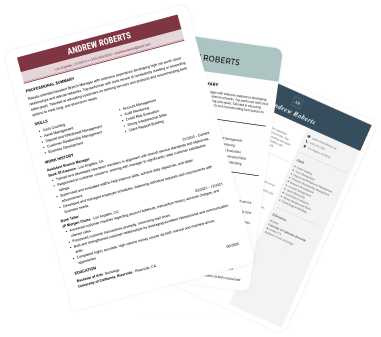Create a professional CV now!
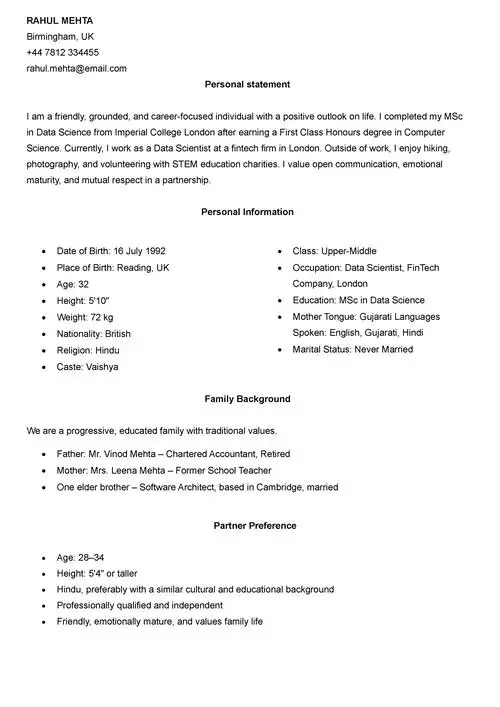 NO
NO YES
YESLast updated on 13 November, 2025

You've built a life you're proud of. Now, you're ready to share it. In many cultures, a marriage biodata—or marriage CV—is vital in this journey.
In this article, I’ll show you how you can craft a marriage biodata that truly represents you and attracts the right connection.
Create an effective CV in minutes. Choose a professional CV template and fill in every section of your CV in a flash using ready-made content and expert tips.
Create a professional CV now!
 NO
NO YES
YESWe created the sample on the right using our builder. See other good CV examples like this one.
Biodata is short for biographical data. In South Asia, particularly in countries like India, Pakistan, and Bangladesh, it’s commonly used in two ways: for job applications and marriage proposals.
A biodata for marriage, also known as a marriage CV, is a formal document used when searching for a life partner. It’s a personal profile that outlines your background, values, lifestyle, and what you’re looking for in a partner. A marriage biodata format will still include insights into your education and current job title, but it’s more about describing who you are as a person.
Life is already complicated enough, so don’t overcomplicate your marriage CV. I’ll now show you what goes into a biodata for marriage. Don’t worry, you don’t need to include everything—just what feels right for you and your situation.
This is the foundation of your biodata for marriage. A lot of personal information goes here, from your name and age to your caste. Here is what you may include in your CV for marriage:
And don’t forget to add a photograph. Take a professional and recent one. Dress up in nice-looking formal or formal-casual attire. Avoid informal photos, especially those that show other people with you.
The digitisation of the matrimonial landscape granted everyone access to a much larger pool of candidates. But just as it is with dating apps, those benefits also come with significant drawbacks. You should be aware of potential discrimination practices, for example, by caste or skin colour, which are deeply rooted issues in matrimonial advertisements.
Marriage is seen as a union between two families. Including family details in your biodata helps others understand your values, upbringing, and lifestyle.
Write this part of a biodata for marriage in the following order:
The "About me" section is one of the few places in your marriage CV where you can write in full sentences and express your personality in a natural tone. It’s your chance to go beyond checkboxes and let the reader feel like they’re getting to know the real you.
While the rest of the biodata for marriage may be more structured, this part offers a chance to be a little more human. This section is usually a short paragraph—around 4 to 6 sentences—which makes it similar to a job CV introduction.
Here’s what to include:
Who are you professionally
Start with a short line about what you do and what you studied. This gives context to your current stage in life and signals how you balance work and personal goals. Mentioning your profession and even touching on your work experience also gives the other person a sense of your routine and lifestyle. For example, it tells them whether you work standard hours, do shift work, or travel for your job.
What your day-to-day life is like
Share a bit about how you spend your free time. This might include your hobbies and interests, weekly routines, or the kind of social life you enjoy. It helps others imagine what it might be like to spend time with you and highlights shared interests or lifestyle compatibility.
Your values and outlook
Include a few words about what matters to you. This could be your approach to relationships, your views on family life, or qualities you value in yourself and others—like kindness, humour, independence, or faith.
Subtle mention of what you’re looking for
You don’t need to list demands or deal-breakers here. Instead, close the paragraph with a gentle hint about what you hope to find in a partner—perhaps shared values, mutual respect, or a willingness to grow together. This creates a sense of direction without sounding transactional. Be very brief, you’ll build on your preferences in a moment.
Overall, your “About Me” section should feel conversational and sincere. You don’t have to be poetic or quirky, like on a dating app.
This section of your marriage CV gives others a sense of what you're looking for in a life partner. Think of it as a way to express what kind of values, lifestyle, and connection would make a good match for you. Don’t treat it as a list of demands; no one likes demanding and entitled people. You may mention:
A strong CV summary will convince the recruiter you’re the perfect candidate. Save time and choose a ready-made personal statement written by career experts and adjust it to your needs in the LiveCareer CV builder.
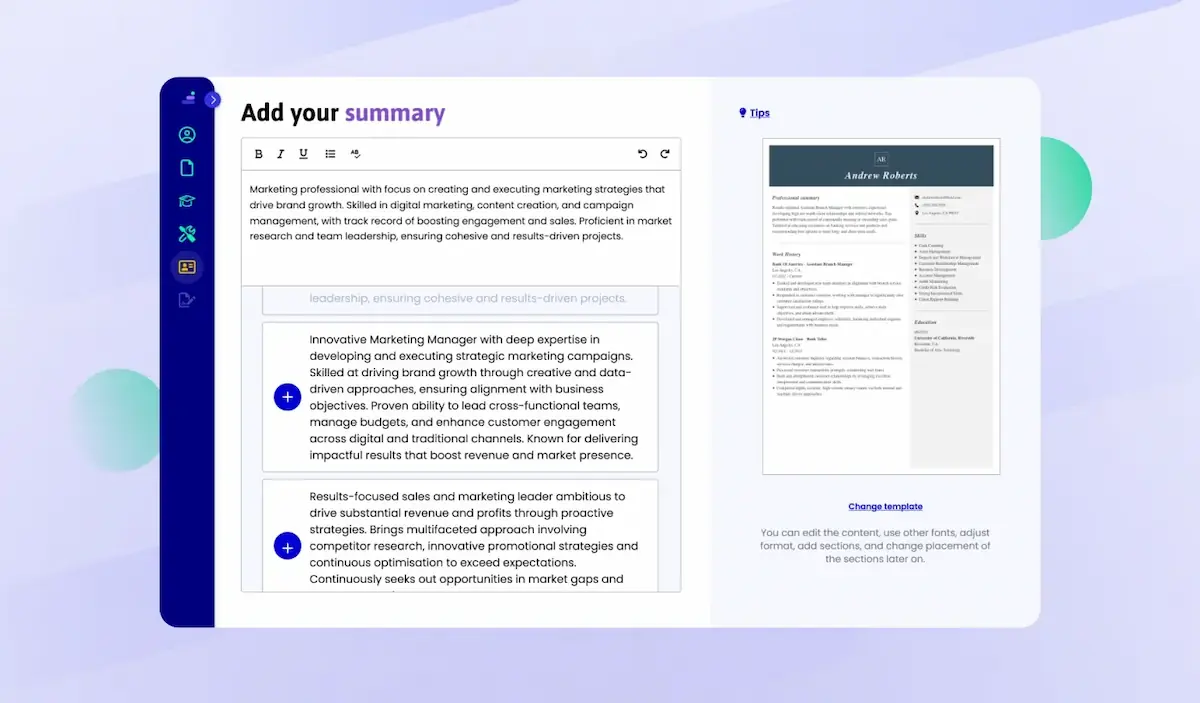
Just like an English CV, a biodata for marriage should be clear, well-structured, and easy to skim through. A good marriage CV format will help you keep all sections neat. Whether you're using a CV template or building your marriage biodata format from scratch, here are some simple rules and smart ways to structure your CV for marriage:
A great trick to simplify formatting is to think of your marriage CV like a lightly adjusted version of a job CV. You can even jump into our CV builder and make the following adjustments to create the perfect marriage CV template:
If you need space for additional parts, such as to expand on your job, education, or spiritual side, you can create and add custom sections to your marriage CV.
Sometimes, the best way to learn is by seeing a real example. Below, you’ll find two sample marriage biodatas—one for a male and one for a female. See how your marriage biodata will look when you create it with LiveCareer.


Biodata is also used in job applications, particularly in South Asian communities and for certain formal or public sector roles. A job biodata is similar to a CV but places more emphasis on personal background and factual information rather than narrative or achievements.
In the UK, most employers request a CV, but if you're applying to roles within community organisations, care roles, government-linked services, or in cultural contexts where biodata is the norm, it’s worth knowing how to structure one properly.
Here’s how to create a job biodata in a clear, UK-appropriate format.
This section appears at the top and outlines your personal details. Include:
Keep the presentation simple and easy to read. A bulleted or tabular layout works best.
List your academic background in the education section of your job biodata, starting with the most recent qualification. Make sure your entries are clear and include:
For UK-based roles, it helps to include recognisable equivalents if your qualifications were completed abroad.
This section should summarise your work experience in reverse chronological order. Include:
When listing your qualifications, do it in the form of bullet points. Start each point with an action verb to convey impact. For a strong biodata for a job, feature as many quantified work accomplishments as possible. If you have limited experience, include internships, placements, or volunteer work.
Include a focused list of 5–8 relevant skills that directly match the requirements of the role you're applying for. Prioritise a mix of technical abilities (like data analysis or software knowledge) and core soft skills (such as teamwork or time management).
Where possible, back up your skills with brief context or evidence—for example, tools you’ve used, certifications you've earned, or results you've delivered.
Avoid listing overly broad traits like “hardworking” or “motivated” without proof. Focus instead on skills you can demonstrate through your work history or training.
While job biodatas are typically brief and factual, there’s room to include extra information, as long as it’s relevant to the role or required by the organisation. These optional sections can help round out your profile and give employers a fuller picture of your background.
Consider including:
Keep in mind: every section should serve a purpose. Avoid adding anything that distracts from your skills and suitability for the job.
A quick note: In the UK, a traditional CV is almost always preferred for securing jobs, particularly in private companies and competitive sectors. I recommend you learn how to write a CV from our dedicated guide.
If you’re certain you need a job biodata, see the example below. It features a finished biodata for a job you can get inspired by, and adapt for your own needs.
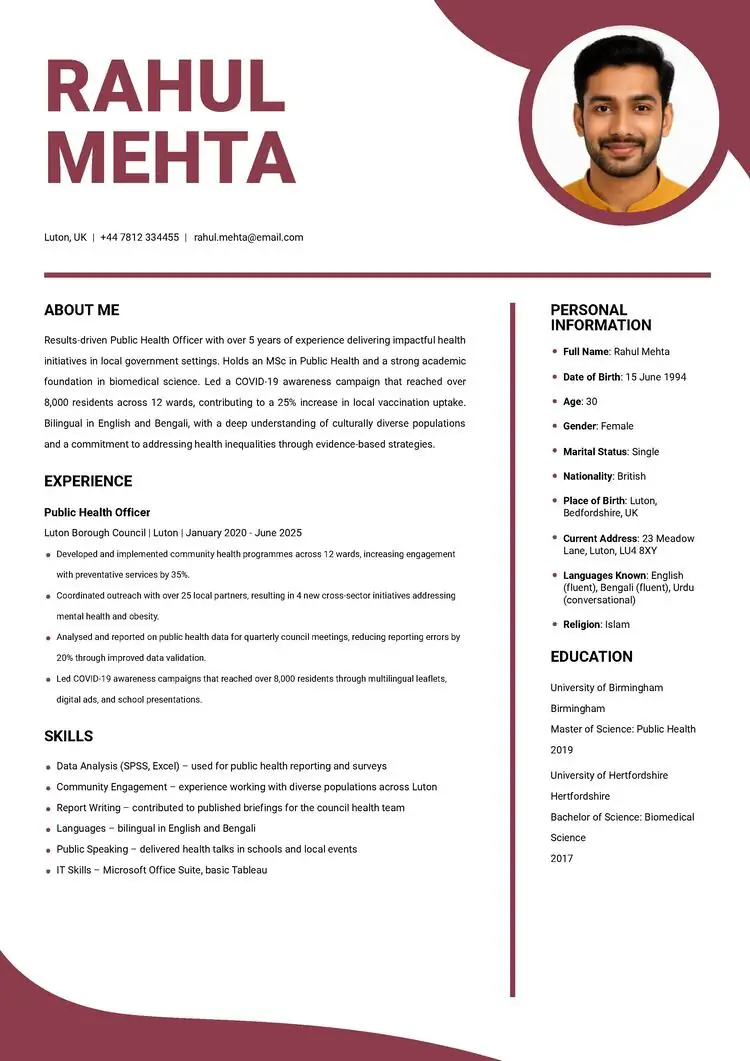
You don’t have to be a CV writing expert. In the LiveCareer CV builder you’ll find ready-made content for every industry and position, which you can then add with a single click.
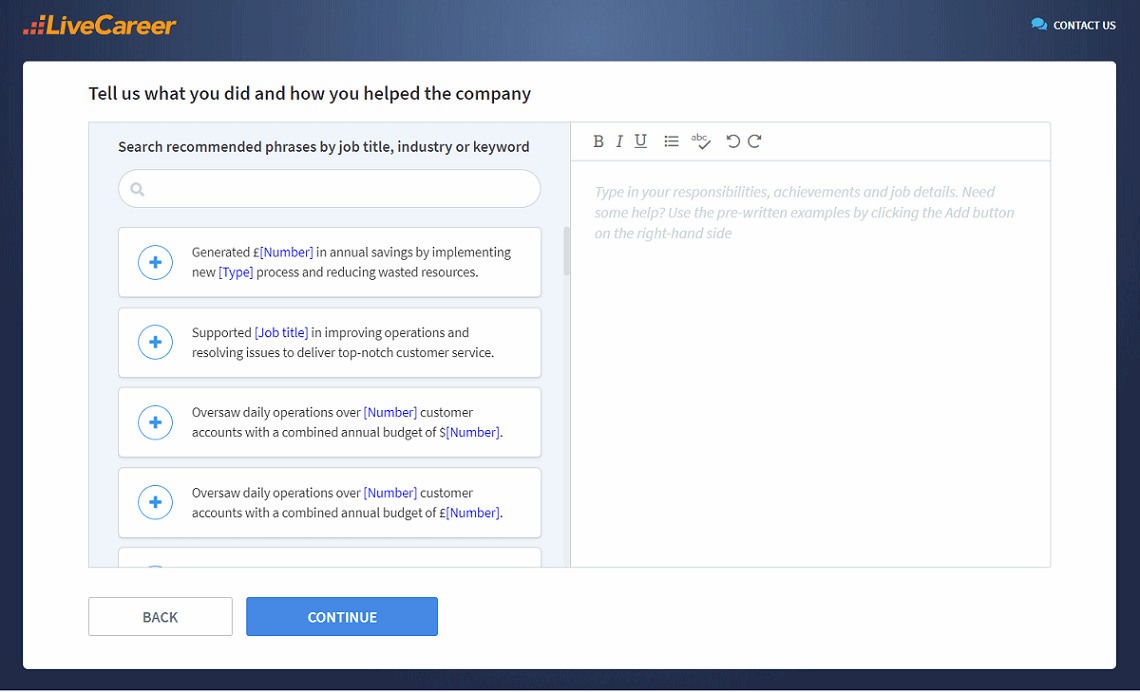
Our editorial team has reviewed this article for compliance with LiveCareer’s editorial guidelines. It’s to ensure that our expert advice and recommendations are consistent across all our career guides and align with current CV and cover letter writing standards and trends. We’re trusted by over 10 million job seekers, supporting them on their way to finding their dream job. Each article is preceded by research and scrutiny to ensure our content responds to current market trends and demand.
Category: CV Help
Crafting a job-winning CV is all about showcasing your unique skills and experiences. Start with a strong personal statement that highlights your career goals and achievements.
Try Our CV Builder Now